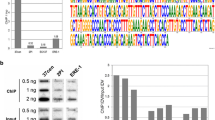Abstract
We have applied EM in situ hybridization (EMISH) and pulsed field gel electrophoresis (PFGE) to samples from diploid primary cell cultures and an established cell line to examine in detail the relative organization of the major and minor satellite DNAs and telomere sequences in the genomes of Mus domesticus and Mus spretus. EMISH localizes the Mus domesticus minor satellite to a single site at the centromere-proximal end of each chromosome. Double label hybridizations with both minor satellite and telomere probes show that they are in close proximity and possibly are linked. In fact, PFGE of M. domesticus DNA digested with Sal I and Sfi I reveals the presence of fragments which hybridize to both probes and is consistent with the physical linkage of these two sequences. The M. domesticus minor satellite is the more abundant satellite in Mus spretus. Its distribution in M. spretus is characterized by diffuse labeling with no obvious concentration near chromosome ends. In addition to this repeat the M. spretus genome contains a small amount of DNA that hybridizes to a M. domesticus major satellite probe. Unlike the M. domesticus minor satellite, it is not telomere proximal but is confined to a domain at the border of the centromere and the long arm. Thus, although both species possess all three sequences, except for the telomeres, their distribution relative to one another is not conserved. Based on the results presented, we propose preliminary molecular maps of the centromere regions of Mus domesticus and Mus spretus.
Similar content being viewed by others
References
Blackburn, E.H. and Szostak, J.W.: The molecular structure of centromeres and telomeres. Ann Rev Biochem 53: 163–194, 1984.
Church, G.M. and Gilbert, W.: Genomic sequencing. Proc Natl Acad Sci USA 81: 1991–1995, 1984.
Feinberg, A.P. and Vogelstein, B.: A technique for radiolabelling DNA restriction endonuclease fragments to high specific activity. Anal Biochem 132: 6–13, 1983.
Hamkalo, B.A., Narayanswami, S., Hildebrand, C.E., and Moyzis, R.K.: Chromosomal organization of telomere sequences in mouse. In Proceedings of the Meeting on Genome Mapping and Sequencing. Cold Spring Harbor, New York, 1989.
Harley, C.B., Futcher, B.A., and Greider, C.W.: Telomeres shorten during aging of human fibroblasts. Nature 345: 458–460, 1990.
Joseph, A., Mitchell, A.R., and Miller, O.J.: The organization of the mouse satellite DNA at centromeres. Exp Cell Res 183: 494–500, 1989.
Kipling, D. and Cooke, H.J.: Hypervariable ultra-long telomeres in mice. Nature 347: 400–402, 1990.
Lica, L. and Hamkalo, B.A.: Preparation of centromeric heterochromatin by restriction endonuclease digestion of mouse L929 cells. Chromosoma 88: 42–49, 1983.
Lica, L., Narayanswami, S., and Hamkalo, B.A.: Mouse satellite DNA, centromere structure and sister chromatid pairing. J Cell Biol 103: 1145–1151, 1986.
Meyne, J., Ratliff, R.L., and Moyzis, R.K.: Conservation of the human telomere sequence (TTAGGG)n among vertebrates. Proc Natl Acad Sci USA 86: 7049–7053, 1989.
Moyzis, R.K., Buckingham, J.M., Cram, L.S., Dani, M., Deaven, L.L., Jones, M.D., Meyne, J., Ratliff, R.C., and Wu, J.R.: A highly conserved repetitive DNA sequence, (TTAGGG)n, present at the telomeres of human chromosomes. Proc Natl Acad Sci USA 85: 6622–6626, 1988.
Narayanswami, S., Lundgren, K., and Hamkalo, B.A.: Deoxyribonucleic acid sequence mapping on metaphase chromosomes by immunoelectron microscopy. Scanning Microsc (Suppl) 3: 65–76, 1989.
Narayanswami, S. and Hamkalo, B.A.: DNA sequence mapping using electron microscopy. GATA 8: 14–23, 1991.
Pardue, M.L. and Gall, J.G.: Chromosomal localization of mouse satellite DNA. Science 168: 1356–1358, 1970.
Pietras, D.F., Bennett, K.L., Siracusa, L.D., Woodworth-Gutai, M., Chapman, V.M., Gross, K.W., Kane-Haas, C., and Hastie, N.D.: Construction of a small Mus musculus repetitive DNA library: Identification of a new satellite sequence in Mus musculus. Nucl Acids Res 11: 6965–6983, 1983.
Rattner, J.B. and Hamkalo, B.A.: Higher order structure in metaphase chromosomes 1. The 250A fiber. Chromosoma 69: 363–372, 1978.
Radic, M.Z., Lundgren, K., and Hamkalo, B.A.: Curvature of mouse satellite DNA and condensation of heterochromatin. Cell 50: 1101–1108, 1987.
Redi, C.A., Garagna, S., Della Valle, G., Bottiroli, G., Dell'Orto, P., Viale, G., Peverali, F.A., Raimondi, E., and Forejt, J.: Differences in the organization and chromosomal allocation of satellite DNA between the European long tailed house mice Mus domesticus and Mus musculus. Chromosoma 99: 11–17, 1990.
Rosenstein, M., Yron, I., Kaufmann, Y., and Rosenberg, S.A.: Lymphokine activated killer cells: Lysis of fresh syngeneic natural killer resistant murine tumor cells by lymphocytes cultured in interleukin 2. Cancer Res 44: 1946–1953, 1984.
Weier, H-U., Segraves, R., Pinkel, D., and Gray, J.W.: Synthesis of Y-chromosome specific labelled DNA probes by in vitro DNA amplification. J Histochem Cytochem 38: 421–426, 1990.
Wong, A.K.C. and Rattner, J.B.: Sequence organization and cytological localization of the minor satellite of mouse. Nucl Acids Res 16: 11645–11661, 1988.
Wong, A.K.C., Biddle, F.G., and Rattner, J.B.: The chromosomal distribution of the major and minor satellite is not conserved in the genus Mus. Chromosoma 99: 190–195, 1990.
Author information
Authors and Affiliations
Rights and permissions
About this article
Cite this article
Narayanswami, S., Doggett, N.A., Clark, L.M. et al. Cytological and molecular characterization of centromeres in Mus domesticus and Mus spretus . Mammalian Genome 2, 186–194 (1992). https://doi.org/10.1007/BF00302876
Received:
Accepted:
Issue Date:
DOI: https://doi.org/10.1007/BF00302876




